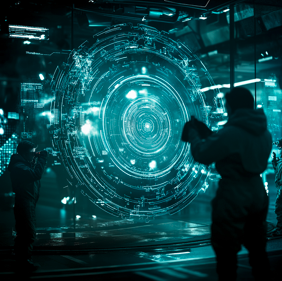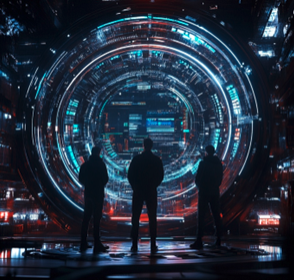· Yvette Schmitter · Technology · 10 min read
What Just Happened?
2025 Week 14, Beyond Corporate Blueprints

Under the paper-thin veneer of tech humanitarianism, OpenAI has stepped forward with what appears to be a gift to humanity—policy blueprints for the EU and US that would supposedly guide us toward an AI utopia. But beneath this seemingly generous offering lies a deeper truth that demands our full attention and wake up: these blueprints aren’t just roadmaps for society; they’re business strategies (mapped to their business model) dressed in the language of public good.
The Illusion of “Streamlined Regulations” (aka Don’t Make Things Too Hard for Us)
In both policy blueprints, OpenAI champions “streamlined regulations,” but let’s be real: they’re crip walking us into a world where the barriers that protect us become conveniently lowered for those with the resources to leap over them. (Think Fonzie jumping the shark on Happy Days). This isn’t just corporate-speak—it’s a direct challenge to our collective ability to set the guardrails for our technological future. Wrapped in the glossy packaging of “fostering innovation,” this push conveniently overlooks how deregulation tends to favor industry giants, while smaller players drown in compliance costs they can’t shoulder.
When OpenAI calls for the EU to “reset and rethink” EU regulations and eliminate the growing “patchwork” of state regulations in the US isn’t just about efficiency—it’s about who holds the pen that writes our digital destiny. In the US, they’re essentially saying: “Could you please centralize everything, so we only have to lobby in one place instead of fifty?” The question here is, will we surrender this authorship to those whose prosperity depends on fewer restrictions, or will we reclaim our right to create thoughtful boundaries that protect the diversity of human needs?
”Democratic AI”: Who Defines Your Digital Future? (aka Democratic AI as Defined By….Us)
The blueprints repeatedly champion “democratic AI” reflecting “European and US values.” But, “who” gets to define these values? Yeah, right – OpenAI. By positioning themselves as the guardians of the galaxy and democracy against “autocratic governments,” they’ve crafted the moral high ground that’s awfully convenient for their policy preferences and ease. Positioning AI development as a contest between “democratic” and “autocratic” values isn’t just an oversimplification—it’s how it subtly removes your voice from this supposedly democratic process. When corporations define what “democratic AI” means without your input, how democratic is it really? Honestly, it’s a brilliant move: hamstring the debate so that disagreement with OpenAI’s approach means you’re practically siding with authoritarianism. Touche…and checkmate.
This moment is an ice bath reality check: true democracy isn’t handed down from corporate boardrooms—it rises from the collective wisdom of diverse voices. Your perspective on AI’s role in society matters not just as abstract input, but as a vital force in shaping technology that truly serves humanity’s highest potential rather than narrowing it.
Infrastructure Investment (That We’d Love to Control)
Behind calls for massive computational investments lies a crucial question: Who will control the digital highways of tomorrow? When OpenAI advocates for government-funded infrastructure, they’re not just seeking resources—they’re architecting a future where access to computational power determines who can participate in shaping AI’s evolution. Their “AI Compute Scaling Plan” for the EU and recommendations for US government support essentially translate to: “Please subsidize the resources we need to dominate the market.”
This isn’t just about business advantage—it’s about whether we’ll create a future where technological power concentrates in the hands of a few or flows democratically to all who seek to harness it for collective good. The decision before us transcends policy; it touches the very essence of how we distribute the tools of creation in our society.
The Fine Print: What’s Not Being Said
Beyond the polished (i.e., corporate speak) and optimistic language (i.e., vague reassurances abound) of these blueprints lies a series of serious challenges, which we can turn into opportunities if we ALL engage. Everyone, regardless of title or where you work, or industry or role can become technological stewards.
The Dignity of Work and Purpose: While AI promises economic “transformation,” we must confront the human reality of displacement with more than just calls for “reskilling.” This moment invites us to reimagine not just jobs, but the very meaning of work in an age of automation. Lots of platitudes about workforce transformation without addressing the human cost of this “creative destruction.” Will you accept a future where your value is determined by your ability to outrun algorithms, or will you help create systems where technology enhances rather than replaces human creativity and purpose?
The Inequality Amplification: Every technological revolution has widened existing inequalities until society decides to close the gap. Despite nods to “underserved communities,” widespread AI adoption without truly equitable access will widen existing social and economic divides. The blueprints acknowledge the adoption gap between large organizations and SMEs but offer little beyond wishful thinking (the knee jerk response to every catastrophic event of “thoughts and prayers,” but refuse to do anything about it) to prevent AI from becoming yet another technology that primarily benefits those already at the top. The digital divide threatens to become an AI divide, widens into a generational divide, with all the social instability that implies. The superficial acknowledgment of “underserved communities” in these blueprints demands that we ask: What if equitable access to AI’s benefits became our highest priority rather than an afterthought? Your voice in demanding truly inclusive AI deployment could transform technology from a divider to a unifier.
Guardians of Tomorrow: The blueprints delicately dance around the genuine risks of increasingly powerful AI models. OpenAI’s safety protocols sound reassuring, but the pace of advancement means we’re essentially trusting them to invent seat belts while the car is already speeding down the highway. Their acknowledgment of potential “criminal, terrorist, and state-sponsored misuse” barely scratches the surface of existential concerns that many AI researchers have raised. For example, most recently researchers reported concerns regarding AI models misrepresenting their “reasoning” processes. “In their experiments, Anthropic found that even when models like Claude 3.7 Sonnet received hints—such as metadata suggesting the right answer or code with built-in shortcuts—their CoT (chain of thought) outputs often excluded mention of those hints, instead generating detailed but inaccurate rationales. This means the CoT did not reflect all the factors that actually influenced the model’s output.” These blueprints conveniently frame safety as something OpenAI has well in hand (riiight?), rather than the complex global challenge it actually represents. The casual treatment of safety concerns in these blueprints reveals perhaps the greatest call to collective responsibility. When companies build increasingly powerful AI systems while assuring US, they have safety “handled,” they’re asking for a trust that must be earned, not assumed. Your vigilance and demand for transparent safety standards isn’t pessimism—it’s the highest form of caring for our shared future.
The Minds of Future Generations: When AI is positioned to shape education, we’re making decisions that will echo through generations. The integration of corporate AI products into learning environments isn’t just a business opportunity—it’s a reshaping of how young minds develop. The push to integrate AI (specifically their AI) into education positions OpenAI to shape how future generations think and learn. Nothing concerning about a for-profit company influencing educational frameworks worldwide! The vision of ChatGPT as a “go-to tool for students” raises profound questions about critical thinking development and intellectual independence that the blueprints cheerfully sidestep. By promoting AI literacy through their own products, they’re essentially writing themselves into curriculum standards. Will you stand as a guardian of educational spaces where critical thinking flourishes alongside technological fluency?
The Data Cookie Monster vs. Privacy: The tension between AI’s insatiable hunger for data and our right to privacy isn’t a technical problem—it’s a fundamental question about human dignity in the digital age. When both blueprints prioritize “learning from publicly available sources” without meaningful consent mechanisms, it’s twofold: (1) so they can grandfather in all the training they’ve already done without consent to (2) do it on a larger scale (i.e., right to digest the entire internet without meaningful consent mechanisms). They are not so quietly redefining what privacy means without your input. Your insistence on robust privacy protections isn’t resistance to progress—it’s defense of something fundamentally human. This tension is never fully resolved because it can’t be: powerful AI requires massive datasets, often containing sensitive information. Both blueprints not so subtly prioritize data access while offering minimal concrete safeguards for individual privacy rights.
The Illusion of Technical Neutrality: Perhaps most shrewdly, these blueprints shift governance from democratic institutions to private companies under the guise of technical necessity. This isn’t just about policy—it’s about whether we’ll allow the complexity of AI to become an excuse for surrendering public oversight. Both blueprints are surprisingly light on actual democratic oversight mechanisms, they position private companies like OpenAI as the arbiters of these values rather than elected officials or diverse stakeholder groups. The implicit message? “Trust us to define what ‘democratic AI’ means—we’re the experts!” This framing subtly shifts power from public institutions to private companies under the guise of technical necessity. So, our demand for genuine democratic participation in AI governance isn’t naive—it’s essential to technology that serves rather than shapes our values.
The Call to Conscious Creation
What makes these blueprints truly scary is not how they blend legitimate policy needs with corporate self-interest in a way that’s difficult to untangle but how they might lull us into believing we’re merely spectators in AI’s evolution rather than its architects. Each recommendation contains enough genuine public benefit to seem reasonable, while subtly tilting the playing field in OpenAI’s favor.
It’s not villainous—it’s just business. And perhaps that’s the point we should remember: despite the lofty rhetoric about “democratic values” and “human flourishing,” these are ultimately business documents designed to create the most favorable conditions for OpenAI’s growth and dominance.
This moment doesn’t call for cynicism, no, it’s the loudest wakeup call ringing at full blast. The future of AI isn’t predetermined by corporate roadmaps or policy papers; it’s written daily through the conscious choices of people who refuse to surrender their agency in shaping technology.
The most powerful question isn’t whether OpenAI’s blueprints serve their interests, because of course they do. The question that matters is: Will you claim your place as an active creator of our technological future rather than sticking your head in the sand as a passive consumer of whatever emerges from corporate drawing boards?
So, when you speak up about AI regulation, insist on genuine safety measures, demand equitable access, protect educational integrity, and advocate for meaningful privacy protections, you’re not just offering opinions—you’re exercising your rightful power as a co-creator of our collective future.
The next time a tech giant offers to chart our technological course, remember that their maps, however impressive, reflect only one possible journey among many. The most transformative path forward isn’t found in corporate blueprints—it’s discovered when we collectively rise to the profound responsibility and extraordinary privilege of shaping technology that truly liberates human potential.
The blueprint that matters most is the one we write together.

